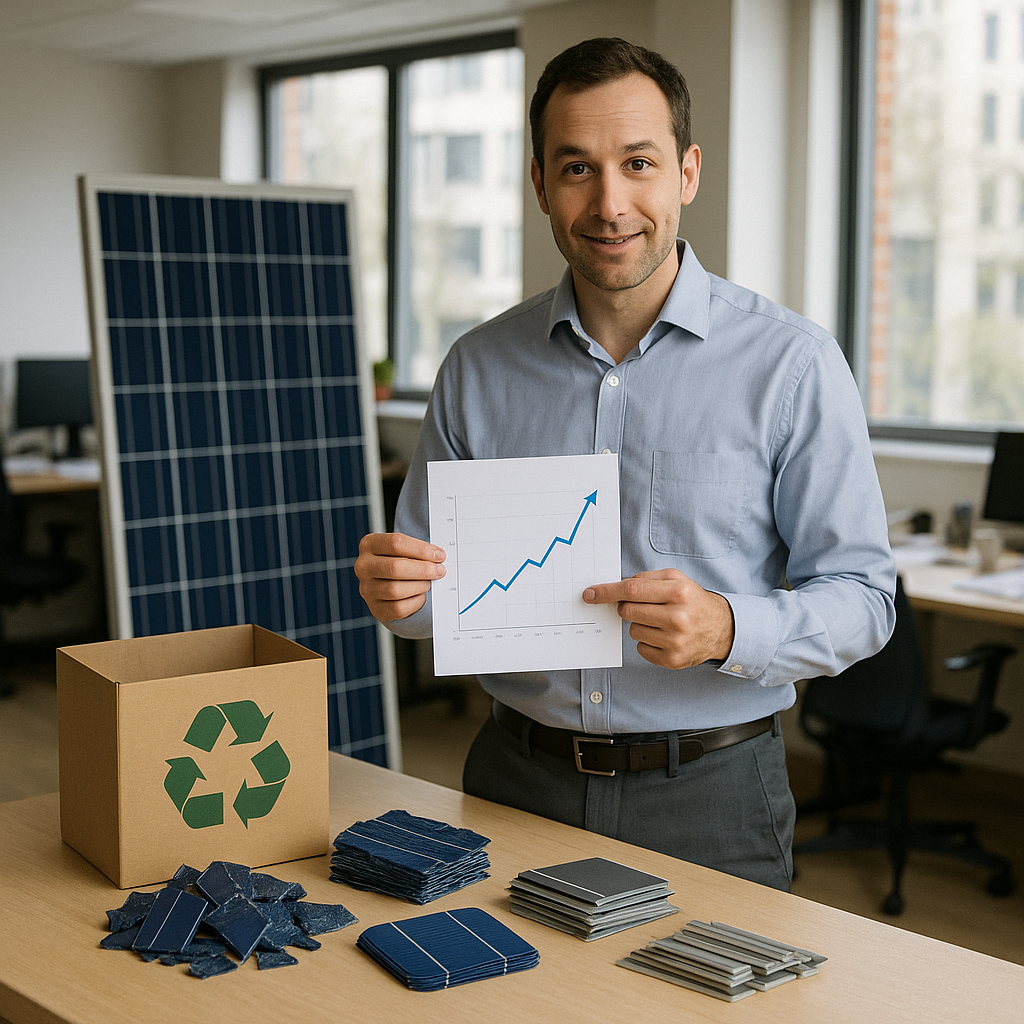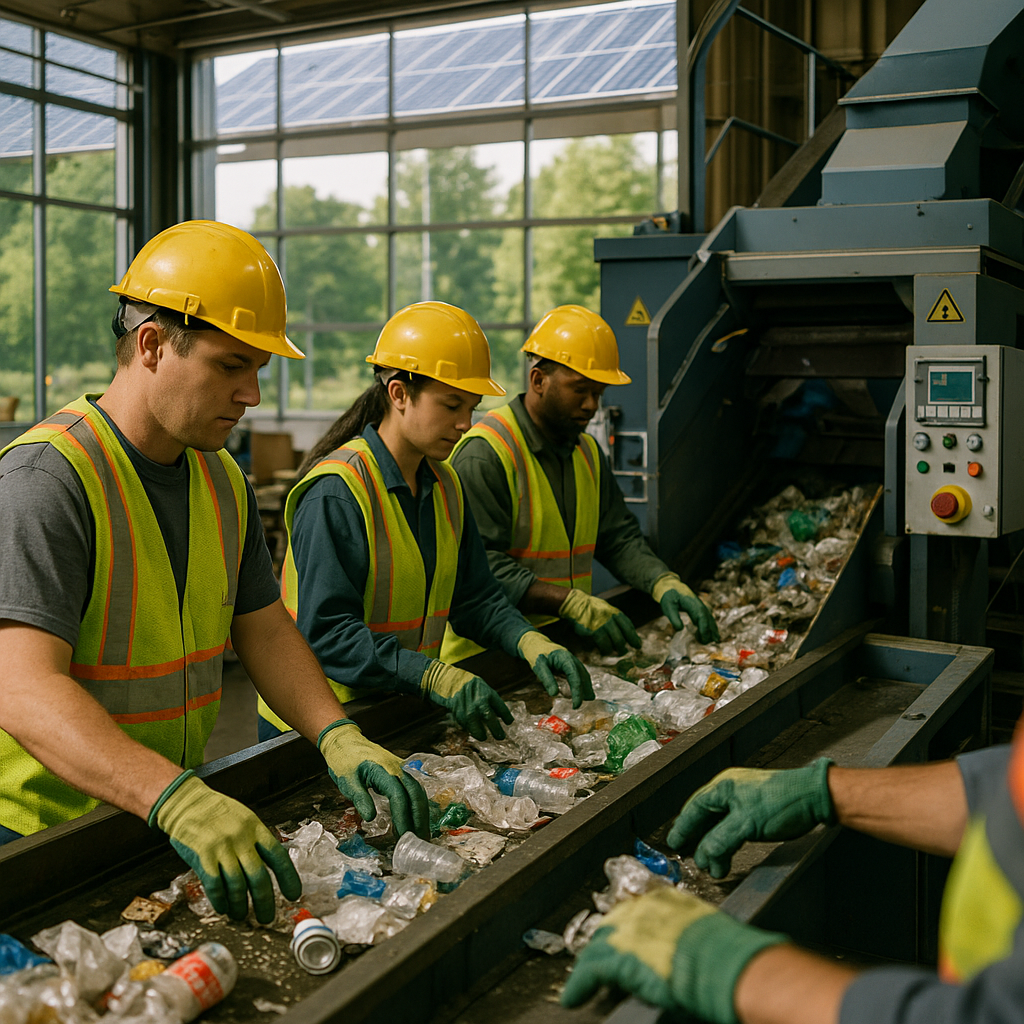5901 Botham Jean Blvd, Dallas, TX 75215
Exploring the Basics of Sustainable Solar Panel Disposal
May 28, 2025By 2050, solar panel waste could reach 78 million tonnes globally. This growing environmental challenge requires immediate attention as the renewable energy sector expands. Without effective end-of-life management, these green energy solutions may undermine their environmental benefits.
Sustainable solar panel disposal offers a solution. This process involves recovering valuable materials from retired or faulty panels. Silicon, glass, aluminum, and rare metals are extracted and reintroduced into the manufacturing stream. Modern recycling technologies can reclaim up to 95% of semiconductor materials and 90% of glass from end-of-life panels.
The benefits extend beyond waste reduction. Proper recycling significantly lowers greenhouse gas emissions associated with new panel production. It decreases demand for newly mined resources, protecting ecosystems and conserving energy. By creating a closed-loop system, sustainable disposal transforms potential waste into valuable resources, making solar energy truly renewable throughout its lifecycle.
What are the Current Challenges in Solar Panel Recycling?
The solar panel recycling industry faces a severe economic imbalance. Recycling a typical residential solar panel costs between $20 and $30, while landfill disposal costs merely $1 to $2 per panel. This stark price difference explains why less than 10% of decommissioned panels are recycled in the United States and European Union.
Economic Viability Issues
The economics create a significant barrier to widespread recycling adoption. Current processing costs far exceed the value of recovered materials, which typically fetch only $3 to $8 per panel, creating an unsustainable business model.
Transportation expenses worsen the financial equation. Collection costs start at $0.05 per watt but can rise to $0.25 per watt depending on site accessibility. Shipping a single container of panels can cost between $1,000 and $2,000.
Labor costs add another layer of expense, varying based on removal complexity, loading requirements, and the number of panels processed. Many recycling operations need a minimum waste volume of 4,000 tons annually to remain profitable.
Lack of Standardization
The solar industry’s rapid growth has led to significant variability in panel composition. Panels contain diverse materials, including silicon, metals like copper and aluminum, and precious materials like silver and gallium.
This material diversity creates complex recycling challenges. For example, First Solar’s thin-film technology differs substantially from conventional crystalline silicon panels, requiring distinct recycling approaches and complicating standardization efforts.
The International Renewable Energy Agency estimates global solar panel waste could reach 78 million metric tons by 2050. Without standardized protocols, recycling facilities struggle to develop universal processing methods.
Infrastructure Limitations
The recycling infrastructure remains inadequate for the growing volume of decommissioned panels. The Solar Energy Industries Association reports only five companies in the United States provide complete solar panel recycling services.
Geographic distribution poses another challenge. Most states lack local recycling options. Florida, for instance, must send its panels to facilities in South Carolina due to the absence of in-state recyclers.
Collection logistics become particularly complicated due to the decentralized nature of solar installations. Panels installed on residential rooftops, commercial buildings, and utility-scale solar farms create diverse collection challenges.
The varied lifespans of solar panels, typically ranging from 25 to 30 years, add complexity as panels reach end-of-life at different times, requiring continuous and adaptable collection systems.
| Disposal Method | Cost per Panel |
|---|---|
| Landfill Disposal | $1 – $20 |
| Recycling | $10 – $40 |
Material Separation Difficulties
The physical composition of solar panels creates technical recycling challenges. Modern panels consist of multiple layered materials bonded together with strong adhesives.
Standard panels use ethylene-vinyl acetate adhesives that require temperatures above 400°C to break down, making it difficult to separate glass, which comprises about 75% of a panel’s weight, from other components.
Silicon cell extraction presents additional complications. Strong adhesives bond the cells to multiple layers, making clean separation difficult. Silver conductors adhere firmly to silicon in thin layers of 10-20 micrometers.
Most separation methods rely on potentially hazardous chemicals like hydrofluoric acid, nitric acid, or sodium hydroxide, requiring careful environmental controls to prevent secondary pollution.
How are Innovative Technologies Improving Solar Panel Recycling?

Recent advancements in recycling technologies are transforming sustainable solar panel disposal. These innovations address a growing challenge, as projections indicate solar panel waste could reach 78 million metric tons by 2050. Developing efficient recycling methods is crucial for the industry’s environmental sustainability.
Mechanical recycling processes have significantly improved in recent years. Modern systems now use advanced robotic disassembly and automated sorting technologies that precisely separate materials. This precision allows recyclers to recover aluminum frames, junction boxes, and glass components without cross-contamination, preserving their value for reuse.
Chemical recycling techniques have evolved to handle the complex composition of solar panels more efficiently. Sophisticated solvent-based methods can dissolve encapsulation materials that previously made material separation challenging. These processes enable the extraction of high-purity silicon and precious metals like silver, a significant portion of a panel’s market value.
Cutting-Edge Separation Technologies
Laser ablation technology is one of the most promising innovations in solar panel recycling. This technique uses precisely controlled laser energy to separate components without damaging valuable materials. It’s particularly effective for thin-film solar panels, where traditional mechanical methods often struggle to segregate the ultrathin layers of semiconductor materials.
Thermochemical recycling combines thermal and chemical processes to optimize material recovery. By subjecting panels to controlled temperature environments with specific chemical catalysts, recyclers can break down composite materials more effectively than either method alone. This integrated approach significantly reduces energy consumption while maximizing material recovery.
Artificial intelligence and machine learning algorithms are transforming sorting capabilities at recycling facilities. AI-driven systems can identify different panel types and materials with remarkable precision, enabling facilities to process mixed batches more efficiently. This technology streamlines operations and substantially improves material recovery rates.
Impressive Recovery Rates
These technological innovations have dramatically improved recovery rates. Advanced recycling processes can now recover up to 95% of semiconductor materials and 90% of glass from end-of-life panels. This represents a significant improvement over earlier methods that recovered less material and often damaged components during processing.
The economic implications are substantial. According to the International Renewable Energy Agency, the value of recoverable materials from solar panels could reach $15 billion by 2050. This creates a powerful financial incentive for continued innovation in recycling technologies and infrastructure development.
Specialized facilities are implementing these advanced techniques at an industrial scale. Projects like ReProSolar, led by waste management company Veolia, are developing comprehensive processes to recover all components of silicon-based PV modules. These operations can process millions of panels annually, handling the growing volume of decommissioned solar equipment.
| Recycling Technology | Recovery Rate (%) |
| Advanced Robotic Disassembly | 95% semiconductor materials |
| Automated Sorting | 90% glass |
| Chemical Recycling | High-purity silicon and precious metals |
| Laser Ablation | Effective for thin-film panels |
| Thermochemical Recycling | Optimized material recovery |
The environmental impact of these innovations extends beyond material recovery. By reusing silicon, glass, and metals from existing panels, the industry significantly reduces its carbon footprint. Recycling prevents approximately 1,200 pounds of carbon dioxide emissions per ton of processed panels compared to manufacturing with virgin materials. This circular approach ensures that solar energy remains sustainable throughout the entire product lifecycle.
Research institutions and private companies continue to explore new frontiers in solar recycling. Biological recycling methods using microorganisms and enzymes to break down organic components show promise as environmentally friendly alternatives. While still experimental, these approaches could provide low-energy solutions for future recycling challenges.
What are the Economic Benefits of Solar Panel Recycling?

Solar panel recycling generates significant economic value through material recovery. The International Renewable Energy Agency estimates that by 2030, recovered materials from recycled solar panels could be worth $450 million globally, enough to produce approximately 60 million new panels.
Job creation is a primary economic advantage of solar panel recycling, generating diverse employment opportunities across the supply chain. Positions are needed for collection, transportation, dismantling, and material recovery. As the sector expands, it will create thousands of new green jobs, contributing to local economic growth and sustainability.
The financial benefits extend beyond employment. Recycling allows for high recovery rates of valuable materials like silicon, glass, and metals. Up to 96% of silicon can be reclaimed and reused, reducing the need for virgin materials and lowering production costs for new panels.
Cost reduction is another key economic benefit. Current recycling costs range from $20 to $24 per 300-watt DC panel, less than 5% of a typical system installation cost. As recycling technologies improve and operations scale up, these expenses are expected to decrease, making the process more cost-effective.
The recycling industry is poised for substantial growth. As more solar installations reach the end of their 25-30 year lifespan, demand for recycling services will increase dramatically, driving innovation and creating new opportunities for businesses and investors.
Market Expansion and Resource Efficiency
The solar panel recycling market shows remarkable potential for expansion. Rising demand will spur technological advancements in panel design and recycling methods, creating new markets for recovered materials and driving further efficiency improvements.
Resource efficiency provides significant economic benefits. High recovery rates for materials like glass, aluminum, silicon, and precious metals reduce dependence on mining and processing raw materials, decreasing production costs while minimizing environmental impact.
Investment in recycling infrastructure generates additional economic advantages. New facilities require capital investment, create construction jobs, and provide long-term employment. Developing regional recycling hubs can revitalize local economies while reducing transportation costs associated with shipping panels to distant facilities.
The economic benefits of solar panel recycling extend to consumers and businesses. As recycling becomes more prevalent and efficient, it could lead to reduced costs for new solar installations, making renewable energy more accessible.
Companies that embrace solar panel recycling often experience enhanced brand reputation and may qualify for tax incentives or other financial benefits, contributing to their bottom line while supporting sustainable practices.
Long-term Economic Impact
The long-term economic impact of solar panel recycling is substantial. By 2050, the global value of recoverable materials from recycled panels could exceed $15 billion, enough to manufacture approximately 2 billion new panels, highlighting the industry’s immense potential.
As recycling technologies improve, recovery rates for valuable materials will increase, making the process more economically viable and driving further industry growth.
The development of closed-loop systems, where recovered materials supply new panel production, offers additional economic benefits by reducing supply chain vulnerabilities and price fluctuations. Manufacturers can achieve more stable production costs and potentially pass these savings on to consumers.
Solar panel recycling creates economic resilience by reducing dependence on imported materials. Many components, particularly rare metals, come from limited geographic sources. By recovering these materials domestically, countries can strengthen economic security and reduce supply chain risks.
Overall, solar panel recycling presents a win-win scenario for the economy and the environment. By fostering job creation, reducing material costs, and spurring innovation, it paves the way for a more sustainable and economically vibrant future in renewable energy.
| Year | Value (USD Billion) |
| 2023 | 0.17 |
| 2024 | 0.39 |
| 2029 | 0.93 |
| 2030 | 2.7 |
| 2050 | 15 to 30 |
Conclusion: The Future of Sustainable Solar Panel Disposal

Recycling solar panels is crucial for maintaining the environmental benefits of solar energy. Advanced technologies now recover up to 95% of materials from decommissioned panels, including precious metals and high-grade silicon. These innovations reduce the demand for raw materials and create a circular economy, transforming waste into valuable resources.
The future of sustainable solar panel disposal is promising. Analysts project the global solar panel recycling market to reach $2.7 billion by 2030. Breakthroughs in automated sorting, thermal separation, and chemical recovery processes continue to enhance efficiency and economic viability. As the volume of end-of-life panels grows and recycling technologies advance, a 40% reduction in recycling costs is expected by 2025.
To ensure solar energy remains a truly green technology, collaboration among manufacturers, recyclers, policymakers, and consumers is essential. By investing in research, strengthening infrastructure, and developing comprehensive regulatory frameworks, we can address current challenges and ensure solar power delivers clean energy throughout its lifecycle. For assistance with your recycling needs, contact Okon Recycling at 214-717-4083.
